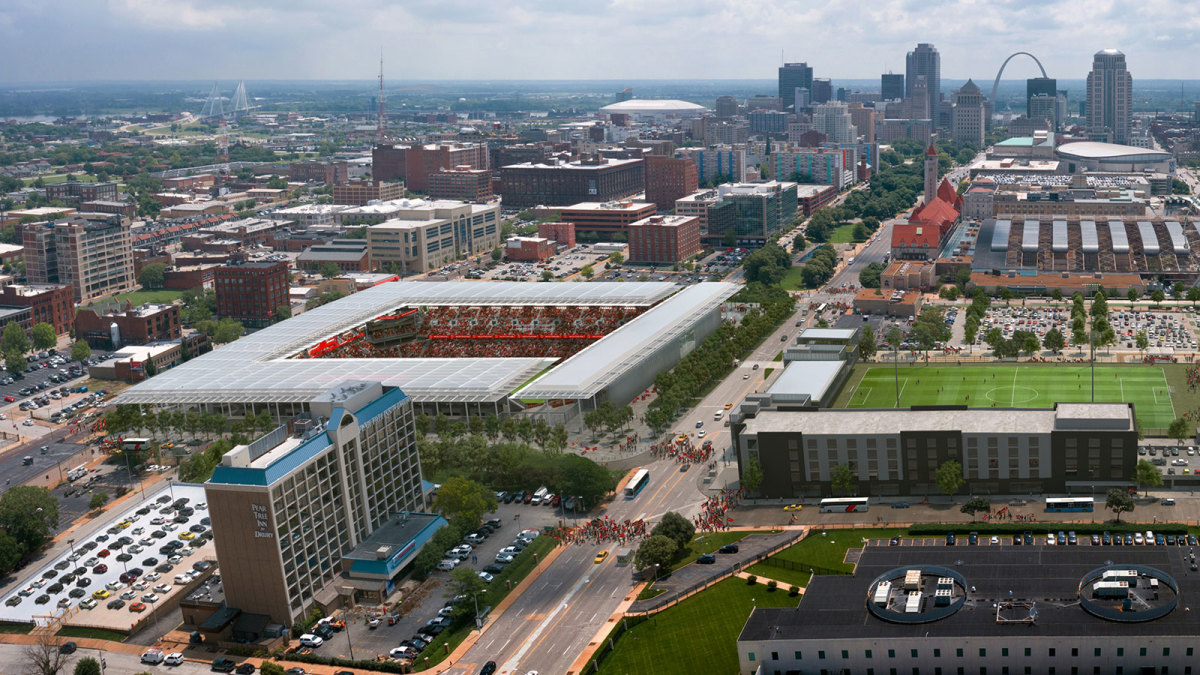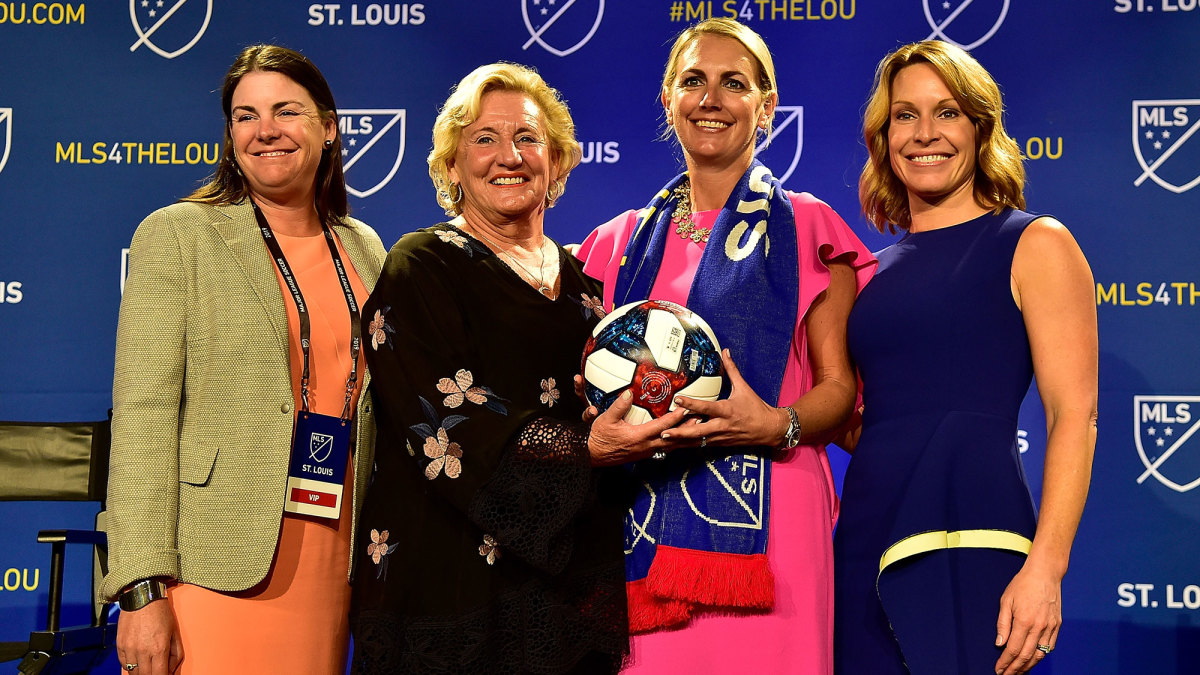St. Louis City SC Reveals Its Name; Now Comes Everything Else
St. Louis’s MLS club has unveiled a logo (there’s an arch and a couple rivers in there if you look carefully), a name (derivative) and colors (unique). Now all that’s left to do between Thursday’s release and the spring of 2023, when the expansion team finally takes the field, is just about everything else.
At least there’s time.
The stadium site, which eventually will be home to a 22,500-seat arena, training complex and team offices, sits just to the northwest of the city’s well-known Union Station and presently is “a massive hole in the ground,” according to St. Louis City SC owner Carolyn Kindle Betz. Workers also found a natural spring, she said. Perhaps that’s a good omen.
The stadium remains on track to open in the summer of 2022. That would’ve been midway through the club’s inaugural MLS season, but last month the league announced a one-year delay impacting three of its four expansion teams. Charlotte FC now will enter in 2022, and St. Louis and Sacramento Republic will join up in 2023. (Austin FC still plans on coming aboard next year).
The extra year “has given us a lot of time to really work with our corporate sponsorship. That announcement came out and they called us to re-engage in those conversations. Our stadium site is on schedule,” Kindle Betz told Sports Illustrated. “It’s a construction project, so who knows? But we’re COVID free, so [when we open] we’ll have a couple months to host watch parties, break in the stadium and see what needs to be [done] so everyone will have that epic first-match experience in March [2023], and that’s very exciting.”

Besides building the stadium and club complex, St. Louis City has to design and fill out its corporate structure and front office; identify and assign roles and appoint a technical staff; figure out what to do about a reserve team and academy; and start marketing season tickets. Kindle Betz was awarded the team last August, and by this spring, there was a sense in MLS circles that St. Louis might be falling behind. Now with an extra year to prepare, the task list doesn’t seem as daunting.
“We’ve really only hired one person,” she said, “and that was Dennis Moore, our chief revenue officer. I think we’re a ways away from [defining a technical and business structure]. So, honestly, it was probably the right time if that decision [on the delay] was going to have to be made, especially in an unknown pandemic. So again, for 10 minutes you’re kind of upset about it. … But after really thinking through it, it was probably a blessing in disguise. It’s allowing us to do things more on our terms as opposed to working on a timeline set by someone else.”
Another executive Kindle Betz considered hiring was long-time U.S. Soccer Federation CEO and secretary general Dan Flynn. He left the USSF last summer, he’s a St. Louis native and he played for the NCAA powerhouse Saint Louis Billikens in the 1970s. It might seem like an ideal fit, but the two sides couldn’t come to an agreement—one source said it was a question of how much control Flynn would have—and negotiations ended.
“I think after having a year under our belt to see how this works, we learned quite a bit,” Kindle Betz said regarding Flynn. “Obviously, Dan is a wonderful man and he’s done great things for the sport of soccer. It’s just that the ownership group had a different philosophy about how to run a club, and so I think it was just better to mutually agree to part ways. He’s still very supportive of us.”
From a technical perspective, St. Louis City is still a long way away from hiring a coach or signing players.
“I think what we would really like to do is bring a chief sporting officer on board and kind of work with them on their vision. You don’t have a vision, hire somebody and say, ‘Here’s our vision make it work,’” Kindle Betz said. “Having that extra year actually helps us because it gives us more time to make sure that we have the right fit.”

The club intends to build an academy system “that is the best in the region,” she said, but it doesn’t currently have a plan to work with Saint Louis FC, the city’s USL Championship team that launched in 2015. Saint Louis FC owner Jim Kavanaugh is a minority investor in the new MLS club.
According to the USL, Saint Louis FC has until the end of this month to commit to playing in 2021 because U.S. Soccer’s sanctioning deadline is in September. If it bows out, there conceivably could be no pro soccer in St. Louis for two years. The franchise rights theoretically could be moved or sold.
“We’ve never had an official formal relation with Saint Louis FC, not to say that we’re not very appreciative of all of their efforts, their supporters group, players, coaches, fans, staff—everything they’ve done for the sport,” Kindle Betz said. “Any kind of decision has to really be made by Saint Louis FC management and ownership over there.”
So for now, St. Louis City is a hole in the ground, a name and a logo. That’s not nothing, however. Both took a lot of work to put together (the previous stadium effort in St. Louis failed under different prospective ownership), and they’re now the foundational building blocks of a club that has more than two years to put everything else in place.
Regarding the name, St. Louis City, Kindle Betz said she hopes it’s something that’ll bring the community together while providing her hometown with the international presence it deserves. City was among the most popular of the approximately 6,000 submissions and suggestions the club received, and in the end it beat out United, Gateway and Stars among “the four names that kind of kept coming back up,” she said.
United is suggested in every poll in every market by fans who think every soccer team should be called that, while Stars was the name of St. Louis’s only other recent top-tier outdoor team, the NASL outfit that played in 1967-77.
Gateway would’ve been the most original and locally relevant choice, but for Kindle Betz that would’ve been a bug rather than a feature.
“You wouldn’t understand Gateway, necessarily, if you don’t live in this region,” she said, adding that the term could be misappropriated and used in phrases like “gateway drug.”
“We want to be an internationally recognized club and Gateway wouldn’t have done it. But City will,” she said.
As for the bright and distinctive pinkish-red that dominates the new badge, the hue is an homage both to Kindle Betz’s favorite color, pink, and the red of the St. Louis city flag. While the vast majority of MLS clubs try to be as bland and indistinguishable as possible in their uniform choices, Kindle Betz insisted, “I didn’t fight for this color to not wear it on the field.”
Kindle Betz said she hopes the upcoming year will bring about the same sort of robust community and commercial engagement encouraged by the naming process.
“I think we definitely have to have some name rights and some founding partnerships solidified so we have some time to really build up the excitement around those,” she said. “We need to really work on getting our season tickets sold and evolving that plan. We need to get our supporters group ready, get them involved in the community, help them start thinking about our mascots and our nicknames. I would say the next year is more engagement on every level. So corporate, fans, supporters, youth engagement, starting to think about what we want our academy system to look like,” she said. “[Next year] will be more people focused than product focused.”
